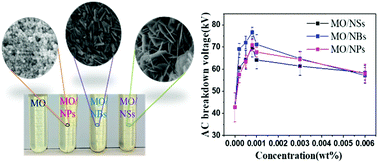Seeking optimized transformer oil-based nanofluids by investigation of the modification mechanism of nano-dielectrics†
Abstract
Figuring out the specific performance and modification mechanism of nano-additives in transformer oil-based nanofluids is highly desired and significantly critical for practical applications. Systematically studying the micro morphologies, dimensions (D) and properties of nano-additives may help us to explore their modification principle more directly. Herein, we design and synthesize homogeneous Co3O4 nanoparticles (NPs), nanobelts (NBs), and nanosheets (NSs) using a hydrothermal method and evenly disperse them in SKALN 25X mineral oil (MO) with a small amount of additive. Since 1D nanomaterials have the largest particle size ratio (length-to-width ratio), the electric field distortion caused by NBs in a strong electric field is smaller than that caused by NPs from the results of simulation by COMSOL Multiphysics. Compared with pure oil, the mean AC breakdown voltage (BDV) of MO/NPs, MO/NBs, and MO/NSs increased by 63.7%, 77%, and 61.6%, respectively. This means that the improvement is higher than that of most transformer oil-based nanofluids (8–45%). Co3O4 is proved to be a new magnetic nano-additive with an excellent modification effect. This work provides an effective strategy for unravelling the full mechanism of modification and may be helpful to guide the research into the scalability of such fluids for applications.



 Please wait while we load your content...
Please wait while we load your content...